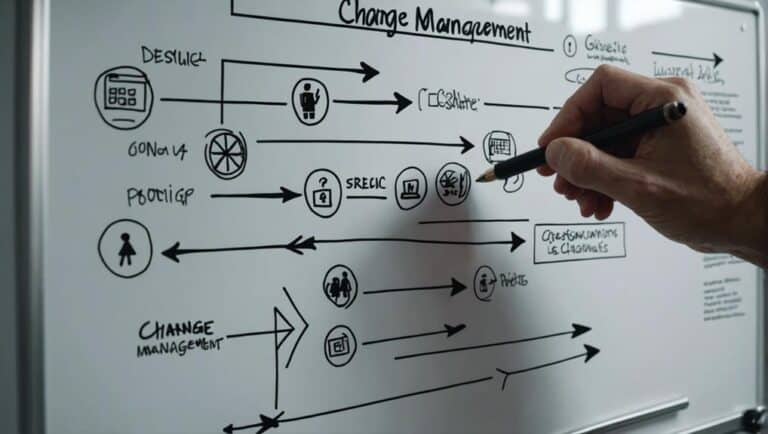When it comes to change management, there are five distinct steps that are typically followed in order to ensure a smooth transition for the organization.
The five steps of change management are assessment, planning, implementation, monitoring and evaluation, and closure.
Let’s take a closer look at each one of these below.
1) Assessment: The first step is to assess the current state of the organization and identify what needs to change in order to achieve the desired outcome. This can be done through interviews, surveys, focus groups, or other data-collection methods.
2) Planning: Once you have a clear understanding of what needs to change, the next step is to develop a plan for how those changes will be made. This includes specifying who will be responsible for each task and establishing timelines for completion.
3) Implementation: Once the plan is finalized, it’s time to start implementing those changes! This can often be the most difficult part as it can involve making significant changes within the organization. However, it’s important to remember that Rome wasn’t built in a day and gradual progress is better than trying to do too much too quickly.
4) Monitoring and Evaluation: As changes are being implemented, it’s important to monitor their progress and evaluate how they are impacting the organization. This can help to ensure that the changes are having the desired effect and make necessary adjustments as needed.
5) Closure: Once the changes have been successfully implemented and are having a positive impact on the organization, it’s time to close out the change management process. This includes celebrating successes, learning from any failures, and putting in place measures to prevent future problems.
Case Study Example
A UK based telecommunication company had difficulty recruiting and training staff quickly enough and to a high enough standard to provide the desired level of customer service. A digital transformation project was created to search for and implement a digital solution to the problem.
Assesment
Having identified the problem the first step looked at what needed to be changed. By creating a customer service focus group the assessment stage uncovered the following:
- New staff were struggling with basic queries because the topic (providing telephone lines and broadband) was a technical one.
- New staff found it difficult to remember all the steps they’d be trained due to the wide variety of potential customer issues.
- Established staff were frustrated because to them each call should follow a standard process, and it took new staff too long to learn each process.
It became clear that the training element was fine, it was offering staff a way to know what process to follow so they didn’t need to try and remember all the different options.
Planning
With issues and desired outcomes identified, a research project was created to look for solutions. In this particular situation the ideal solution was the implementation of decision tree software.
If you’re not familiar with decision tree software, it allows you to create an easy-to-use interface that prompts advisors with questions to ask customers. When they press the answer option given either another question is asked or a solution is provided.
Think of it as a way of travelling through a process map without seeing the entire map at once.
There are lots of options available. In this particular situation, Zingtree was selected for its balance between price and features.
The second stage of planning involved selecting a small group of advisors to be responsible for first building an example decision tree and then managing a live test with a small group of new advisors.
Implementation
This was broken into several sections. First the trial was implemented. This gave a few new and existing advisors the chance to test the software out in a live environment when on calls to customers.

The plan called for a ‘minimum viable product’ approach. Rather than implement a solution for all calls, some of the most common issues were addressed via decision trees.
Any incoming calls with those specific problems were routed to the prototype team who would test the tree and make adjustments to it based on user feedback.
Monitoring and Evaluation
During the trial feedback was constantly being gathered from advisors regarding the decision trees and how each they were to use.
Call resolution times were also monitored.
As feedback was gained, additional changes were made until the trial advisors had no further feedback that needed to be addressed.
It was then back to the implementation stage, rolling out the new platform to more advisors and to cover more customer queries.
An advantage of this particular platform is it can also be used by customers. Additional customer specific decision trees were created and published online, allowing customers to self resolve issues which reduced the number of inbound calls to customer service agents.

Closure
With the system fully rolled out the main project was transitioned into a business as usual process, with responsibility for the Zingree platform passed from the project team to the IT team (from a technical point of view) and customer service team (from a decision tree development point of view).
The change was considered a huge success. Calls were being handled better the first time and new staff felt far less overwhelmed because they had a system which held their hand to the correct solution.
This is just one example of how the five key steps of change management are applied. It’s important to remember that there is often some back and forth between the steps, when you get to evaluating the change so far you may find further planning and implementation is required before progressing further.
Why is change management important?
Change management is important for successful project management because it helps to ensure that everyone in the organization understands and agrees to change.
It also provides a structure for implementing changes and tracking their progress.
Change management can be difficult, but with the right tools and techniques it can help businesses adopt change more smoothly and efficiently.
What are the benefits of change management?
When it comes to making changes in your organization, such as implementing a new application, change management can help make the process smoother and more successful.
Change management is the orchestration of changes and not just a new process or instruction that something has changed.
It is a key component of any business strategy. By adopting a structured approach to managing change, management teams can reduce risk and increase efficiency when it comes to changing processes.
In order for change management to be effective, it must be tailored to the specific needs of an organization.
You can see from the example above that an effective change management plan ensured that everyone involved understood why the change is happening and how it impacted them. It also provided a structure for implementing and monitoring the changes so that they are carried out efficiently and with minimal disruption.
By taking the time to implement change management, you’re making an investment in the future of your organization that will pay off in the long run.
What are the challenges of change management?
Any change management process is going to be fraught with challenges. The science of change management is constantly evolving, as consumer expectations and the competition in the global economy evolve. So it’s no wonder that businesses have a hard time keeping up!
A successful change management process involves planning, securing buy-in and resources, developing strong communication norms, and continually evaluating processes. But even with all that work put in, things can still go wrong.
Change management is complicated by the business terrain’s evolution; as companies try to keep up with ever-changing customer demands, they often have to make changes themselves. This can create havoc within an organization and lead to damages that are sometimes irreparable.
Change management is necessary for business survival; without it, organizations risk being left behind. However, implementing a change management process does not come without its own set of challenges. Employees may resist changes or feel overwhelmed by them–leading to reduced productivity or even job loss.
And if things slip through the cracks during implementation, the consequences can be disastrous for a company. Read more about the fear of change management here: The Fear of Change: Why Is It So Hard For People And Companies To Accept Change?
How can change management be used to improve organizational performance?
In order for a company to improve its organizational performance, it is important that the employees embrace change. Change management is a step-by-step process that helps an organization transition smoothly from one state to another without obstructing workflow or suffering any damages. It includes practices and procedures that need to be identified and followed in order for the change to be successful.
A brand like Blackberry, with over 80 million users worldwide, failed to adopt touchscreen technology and better operating systems fast enough, and it became obsolete and lost out in the long run. In times like these, it’s crucial for companies to embrace change in order to keep up with or stay ahead of the competition.

Change management is used by organizations all around the world as a way of improving their productivity and ensuring their survival in today’s fast-paced economy. By following a change management process, your company can make changes more effectively and efficiently without disrupting operations or damaging employee morale.
What are the best practices for change management?
When it comes to change management, there are a few key best practices that should be followed in order to ensure a smooth transition.
The first step is to identify the goals of the change and what needs to be done in order to achieve them. After that, the organization itself must be assessed, including all employees and their roles within it.
From there, collaboration and communication between all stakeholders becomes critical in order for everyone to be on the same page.
Last but not least, implementation of the new process or system must happen in a methodical way so as not to disrupt business continuity.
All of these steps are necessary for a successful change management initiative. By following them closely, organizations can minimize risk and ensure that their employees are ready and willing to embrace changes in how they work.
How can change management be used to facilitate organizational change?
When it comes to organizational change, change management can be extremely helpful. There are five stages that employees go through when they experience a change in their environment, and change management procedures help to smooth the way for them.
The first stage is denial, followed by bargaining, anger, depression, and finally acceptance.
Change management helps employees to gradually accept the change and participate in the process. This can prevent any damaging outcomes that may come from resistance to change.
In addition, change management helps to resolve any obstructions that may get in the way of organizational change.
By addressing potential roadblocks head-on, you can ensure that your organization will be able to make changes smoothly and without interruption. Facilitating organizational change with the help of change management is essential for companies who want to stay competitive in today’s market!
What are the pitfalls of change management?
While it’s important to have a change management process in place so that changes can be made without compromising operations, there are some pitfalls that can occur during the change management process.
One such pitfall is when employees don’t buy into the change. This can happen when employees feel like they’re being asked to do too much or when they don’t understand why the change is happening.
In addition, if employees don’t feel like they’re part of the decision-making process, they may not be as willing to implement the change.

Another pitfall is when managers try to make too many changes at once. This can lead to confusion and chaos in the workplace.
Managers should take it slow and make sure everyone understands what’s happening before making any additional changes.
Finally, one of the biggest pitfalls of change management is when it doesn’t work out and the organization has to go back to the old way of doing things.
This can be costly and time-consuming for an organization, so it’s important to plan for success before implementing any changes.
What are the success factors for change management?
There is no one-size-fits-all answer to this question, as the success factors for change management depend on what part of your business is being changed. However, there are some general guidelines that can help increase the chances of a successful change management initiative.
Some key success factors include a strong work ethic, a company culture that supports change, and effective communication across all levels of the organization. Without these elements in place, it will be much more difficult to successfully implement changes within your business.
Change is an important part of any organization’s growth and survival. By implementing a well-planned change management process, you can make sure that changes are made effectively and without causing too much disruption to your day-to-day operations.
What Are the Key Steps in Driving Organizational Change According to The Five Steps of Change Management?
The key steps in driving organizational change according to the five steps of change management are: 1) creating a sense of urgency, 2) forming a powerful coalition, 3) creating a vision for change, 4) communicating the vision, and 5) removing obstacles and setting achievable short-term goals. These steps are crucial for driving organizational change successfully.
Final thoughts
Change management is something that must be factored in to management strategy. Handled correctly it will vastly improve your ability to complete your business objectives, however it is only successful if senior leaders buy into the process.
Gathering employee feedback, monitoring key performance indicators and having clear communication strategies in play will all ensure the transition from the current process or situations to the new state takes place far smoother than if you’ve not considered an adoption process.





